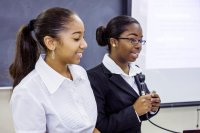Making Assessment a Collaborative Process
A middle school teacher turned an individual assessment into a group presentation with an authentic audience and three layers of feedback.
Your content has been saved!
Go to My Saved Content.“I like it when we get to talk and work with each other.”
I kept reading some version of that statement over and over again in my quarter one student feedback form. It really struck me because I was about to give my students a final assessment that was individual and required no collaboration.
Thinking of all the time I had spent working on building that assessment, I paused for a moment. I considered keeping it and doing a collaborative assessment next quarter. But though that would make things easier for me, it was not what my students were telling me. If I was gathering their feedback but not using it, then why was I even asking for it? So I decided to make peer feedback an essential part of the assessment. That small adjustment grew into an annual event in which a student product combines peer and teacher assessments with self-assessments to help students take ownership of their learning.
Authentic Audiences and Opportunities to Collaborate
In this annual event, I worked with my partner teacher and program coordinator to guide students in preparing to present to their families their learning on a topic they were interested in or something about AVID, our college and career readiness program. The purpose of the night of presentations was to educate parents and caregivers about our specialized program and to provide students with an opportunity to showcase their presentation and collaboration skills. It was also a chance for my school team to meet families and show them how incredible their kids could be if given the chance to shine.
We couldn’t have all 275 students in the elective program present in the evening event, so we utilized periods during the school day to do formative and summative assessment presentations. In the formative assessment round, my students presented to my partner teacher’s students in the program. After reading their peers’ feedback, self-assessing, and listening to my feedback, students would make improvements. In the summative assessment round, our students presented to students who were not familiar with the program. These students from different content classes were essential in selecting the groups or individual students to present at the family night.
Multiple Sources of Feedback
My partner teacher and I gave our students parameters to work within. Sixth-grade students who were new to the program collaborated in small groups on topics they were learning in class, turning their learning into a game they would use to challenge how well their peers understood the material.
Seventh- and eighth-students who had been in the program for at least a year worked in triads or pairs or on their own on something related to their career of choice. If a student wanted to be a writer, they would write a short story. If they wanted to be a clothing designer, they would make sketches of clothing. (Nearly all students who started the program in sixth grade stayed through eighth grade; we were also open to accepting students during the year, but this was rare.)
While we had two sets of parameters for the projects, all students had the same rubric, which they used to assess their general learner outcomes and other standards related to the content area.
The most important item on the rubric was their execution of their presentation, and they were assessed on that by those peers from classes outside of AVID. These peer reviewers worked in groups—usually about six groups of four or five students, which would mimic the typical size of families that attended the event.
The peer reviewers listened to the presentations, asked questions, and gave feedback using a template. They wrote down questions about the presentation, ideas for improvement, and one thing they liked. The presentations took two days in 90-minute periods—half the class would present on one day while the other half of the class worked on something else with my partner teacher in the other classroom.
My students craved an authentic audience, and the peer reviewers were the perfect audience. Their feedback gave the presenters a sense of immediacy as well as critical commentary.
Once all students had given their presentations, I collected all the feedback and then asked students to self-assess using the rubric. Students now had three sources of feedback—their peers’ rubrics, their own self-assessments, and my feedback.
It was nearly always the case that students were far more critical of their work than their peers or even me. They would discuss with their team what improvements needed to happen if they were selected to present to the families. What I found was that students were spot on with their self-critiques. Because they knew they had a real audience, they would put in a lot more effort than if I had them simply present to the class. They were aware that they were representing their program for the rest of their grade and potentially for parents and family members as well.
Guiding students to accurately self-assess their learning, in part by sharing other assessments that can help them put their self-assessments into perspective, helps them grow and take ownership of their learning.
